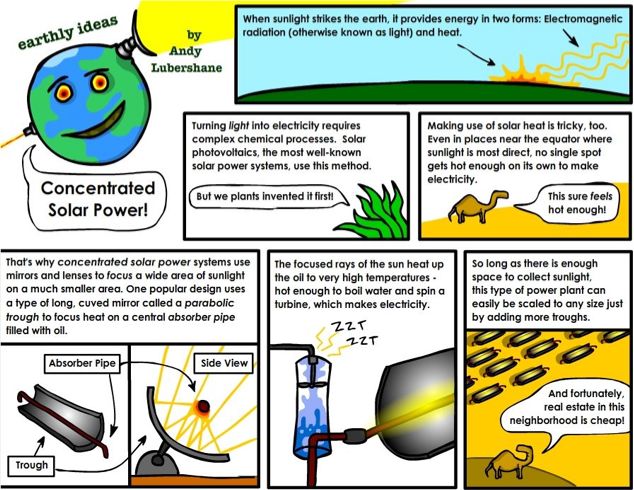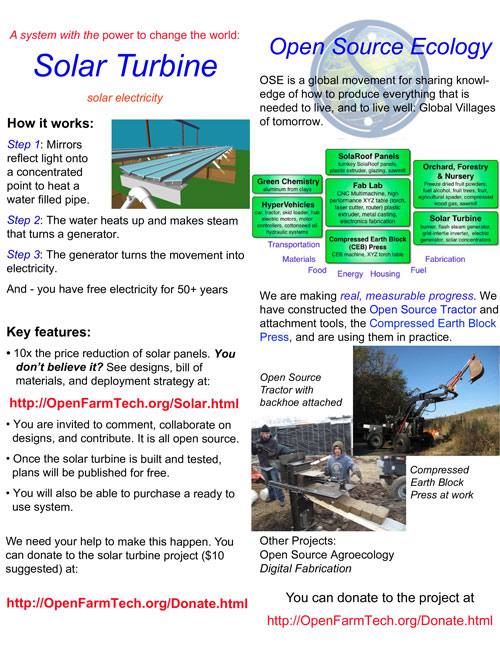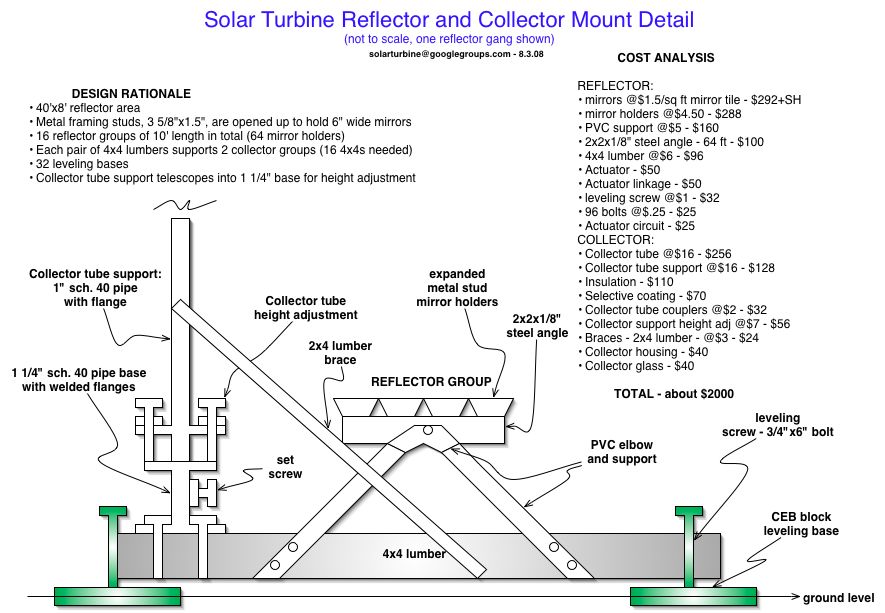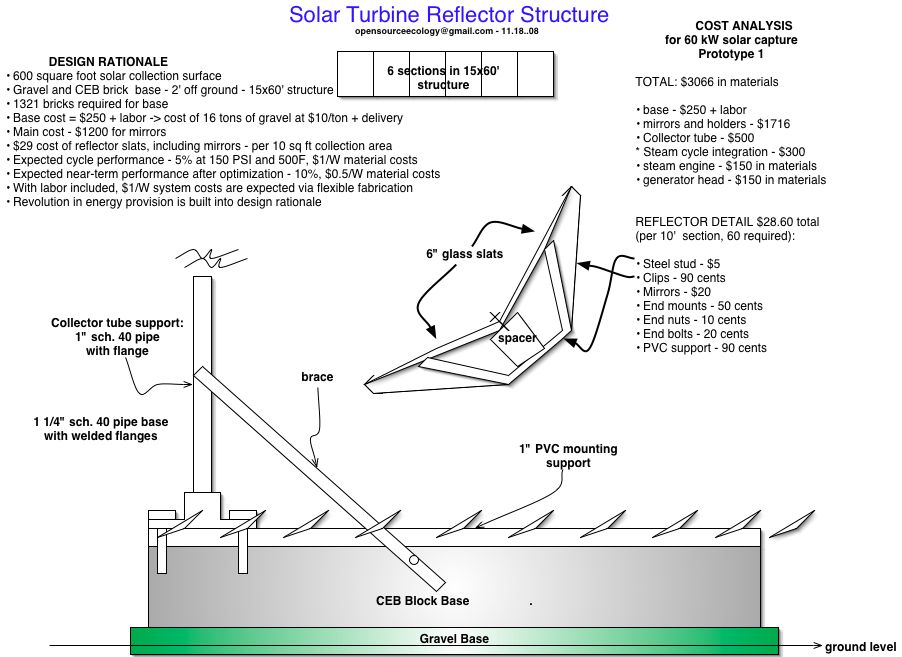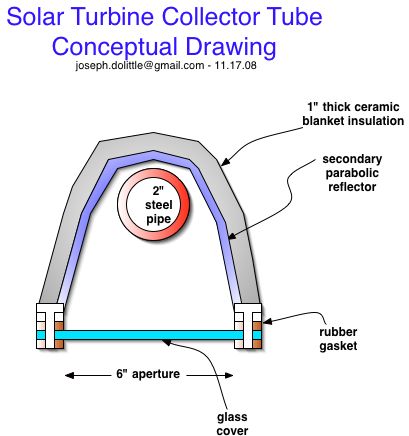Solar Turbine Working Paper
Main > Energy > Solar Power > Solar Turbine
Breaking Cost Barriers in Solar Electricity Production via Community Supported Manufacturing
OSE Working Paper #1
v0.1 – joseph.dolittle@gmail.com - 11.13.08 v0.2 - updated 1.30.09
Foreword!
We begin with a simple cartoon explaining concentrator solar power. Note that we are not using troughs, but flat slats for concentration. We are using water as the working medium, but with a simple steam engine. Moreover, we aim to demonstrate feasibility not only in desert areas, but most of the temperate zone.
(source: worldchanging.com)
Abstract
Herein we propose a method for manufacturing solar thermal concentrator (STC) electric systems – the Solar Turbine - at $1/watt – for a system with a 50 year lifetime. We invoke a novel Community Supported Manufacturing (CSM) model.
(here is a link for a high quality .jpg of this file,1.1M, and a PhotoShop source file, 12M)
Introduction
Basic analysis shows (ref 1) that the cost of solar thermal concentrator (STC) electric systems may be 10 times lower than that of photovoltaics (PV). While complete turnkey PV system components cost $20 per watt, (ref 2) herein we show the basic design and implementation program for an STC systems at approximately $1/watt.(ref 3) This prediction is deliverable by a Community Supported Manufacturing model.
This working paper is submitted for careful review by the reader. We welcome any comments/controversies regarding any specific point mentioned in this paper. If this analysis is accurate, then a major breakthrough would have been achieved for renewable energy provision by humankind.
We understand that solar power generation predictions at $1/watt are ‘highly suspect.’(ref 4) We invite the reader to poke holes in any of the arguments – along the lines of a collaborative effort for implementing the above projections in practice.
Moreover, we understand that STC systems do not perform in diffuse sunlight. This does not detract from the economic viability of STC – in that energy storage is utilized just as in PV systems. For example, even if STC captured only 50% as much of the solar energy as PV, then a 10-fold cheaper STC system is still 5-fold as attractive as PV from the standpoint of cost for a given performance. This would reduce the attractiveness of STC in cloudy areas, but not in primarily sunny areas.
Analysis Basics
This analysis begins by examining the solar energy-capturing substrate in both systems. For photovoltaics, that is the cost of solar cells – which are $40/sq foot for the lowest cost option. (ref 5) For STC systems, that is high-iron glass mirrors – which is $2/sq foot. (ref 6) We are assuming an overall system cycle efficiency of 10% for PV, and 7.5% for the Solar Turbine – such that we are relying on proven performances with respect to the STC concept.
This analysis and implementation procedure invoked in this study is based entirely upon proven techniques utilized for energy capture and conversion. Namely, we are using a simple, single-piston steam engine as the energy conversion device. Single-piston team engines that existed since the turn of the 19th century have demonstrated overall cycle efficiencies of 26%. (see p. 317 in [1]) We are basing our analysis upon such proven results – including a 50% solar reflector/collector efficiency – to arrive at an overall 7.5% efficiency mentioned above. In particular, we are relying on creating an 18% thermal efficiency steam engine, which for the temperature conditions in question, is an empirically proven result.
It should be noted that even with the low, 5% efficiency, our overall STC system design yields factor 10 price improvements compared to PV. We are pointing out that simple, proven techniques are already sufficient to produce the next energy evolution – towards a decentralized society enjoying a high quality of life. Therefore, this proposition should be considered by any change agent.
Key To Success
The key to the low cost mentioned above is the utilization of a novel community supported manufacturing (CSM) enterprise model. This model involves collaborative funding and development effort. In this effort, a large number of stakeholders develop the Solar Turbine. These stakeholders fund the production facility voluntarily, and they receive an at-cost product. (ref 8)
Presently, Factor e Farm is planning to build these Solar Turbines. We also invite other co-developers to engage in parallel product development and fabrication tooling development. This is an entirely open source project, which relies on collaborative development to distribute risk.
The largest fraction of this effort relies on integrating a large number of components for a complete system – utilizing knowledge from a number of fields. That is, ‘intellectual property’ is the largest cost in the effort. The second largest cost is capitalization required for tooling, such that mass production (ref 9) costs may be attained.
By developing the Solar Turbine via open source techniques, the above costs are subsidized. Community Supported Manufacturing is utilized to pay for fabrication capacity of key components that are not available off the shelf. All together, low cost is a result of effective fabrication techniques, which utilize digital fabrication in cost optimization.
Fabrication Capacity Development
Fabrication of the Solar Turbine requires primarily off the shelf components, as well as custom fabricated parts. The off-shelf components include:
- mirrors
- mounting structure parts
- collector tube parts
- actuators
- electrical generator.
These components may be assembled into the Solar Turbine in any flexible workshop. Basic fabrication techniques are utilized to produce the steam engine, collector tube, and steam cycle components.
The fabrication procedure for the Solar Turbine includes
- Assembling a mounting structure for mirrors, including a solar tracking mechanism
- Fabrication of the collector tube
- Fabrication of steam engine – metal melting, casting, lathing, and related machining
- Integration of steam cycle, with water delivery, exhaust, recycling, preheating, cooling, etc.
Costs
Here we show how the $1/watt cost is achieved.
We start with high-iron glass mirrors at $2/sq foot. Each square foot captures about 100W of energy. Given that the overall efficiency of the system is 5% - each square foot yields 5 watts of electrical power output coming from the electrical generator. If only mirrors were required, this would make the cost of solar electricity $2/5W, or 40 cents per watt. Therefore, we have an allowance of 2.5 times the cost of mirrors, or $5, for the cost of $1/watt. If mirrors cost $2, then we have $3/watt for the balance of system cost.
Our basic predictions are as follows for a system consisting of 600 sq feet of mirrors – or 60 kW of solar capture capable of producing 3 kW if the overall system efficiency is 5%. This system is sufficiently large to provide sufficient electrical power to a household, at an average rate of about 750W. We calculate this by dividing the 3 kW by 4, to account for the fact that the sun may typically shine for 6 hours in a given 24 hour period. Half of this period is night time and further reduction accounts for cloudy days.
In the entire system, we allow a total of about $3000 for the entire system:
- $1200 for the mirrors
- $800 for the structure
- $500 for the collector tube and valving,
- $250 for the steam engine
- $250 for the generator head.
Cost Optimization
Initial Structure
We have started with a collector cost of $2000 for 32 kW of solar intercept -
Structure Optimization
updated 2.1.09
We optimized the above to $3066 for 48 kw of solar intercept, materials price - including steam engine and generator:
Assumptions for above design:
- CEB block is available; can be pressed with 5 people in 1 day with a manual CEB machine. Fuel costs - $4. LifeTrac or equivalent available. Small rototiller available.
- Steam engine is fabricated in-house using available metal casting infrastructure.
- Metal casting infrastructure developed and paid for via CSM crowd support – cost of $400.
- Lathe – developed in-house for $400 in materials for high performance, 12” lathe.
- Mass production (by the masses) capacity developed via open source design.
- CNC lathing (open source) and mold making (open source 3d printer) assist mass production.
- Generator heads are made in house, with major cost being that of magnets.
- Fabrication jigs for generator heads are CSM supported.
- Labor requirements for steam engine fabrication – 3 hours after optimization
- Labor requirements for generator heads – 3 hours after optimization
- Assembly of reflector slats in flexible fabrication facility – 5 minutes per slat (60 total slats required) after optimization a (total of 5 hours)
- Labor requirement for collector tube – 2 hours after optimization
- Total labor requirements – 13 hours for component preparation
- Outsourced labor cost - $260 at $20/hour for semi-skilled labor
- Installation costs – yet undetermined
- Installation costs – similar to that of photovoltaic panels
Proof of Cost Predictions
Proving the above cost requires proving the following:
- Mirrors - Verifying sourcing and availability of $2/watt mirrors
- Mirror mounting - Proving the cost of the mounting structure and tracking system at $800 for the 60 kW solar capture
- $700 for structure, including actuator mounting
- Spot welder and 3/4 mm galvanized angle for structure, based on UK Linear Concentrator Prototype
- $50 for actuator
- $50 for controller
- $700 for structure, including actuator mounting
- Collector tube - Proving the collector tube plus valving cost of $500
- Collector tube assembly - $400
- Valving and controls - $100
- Steam engine - Proving the $250 cost
- Steam engine - $230
- Mounting enclosure - $20
- Identifying a source of a 3 kW generator head for $250, and fabricating it in-house in later phases
Once all these points are proven, then the $1/watt cost for the system stands as true.
Procedure for Proving Cost Predictions
Proving the individual points above requires
- Obtaining 3 bids in writing – quote, availability, and shipping times for high-iron glass mirrors
- Showing an explicit design on paper for all the components
- Documenting efficiency losses – all the way from solar income to electrical power from the generator head – to obtain 5% overall efficiency
- Implementing one modular unit of each component (such as one gang of reflector slats, one collector section, a steam engine) to prove the cost predictions. Modular design allows component testing to be carried out at low cost.
- Building and testing the steam engine
- Optimizing cost of steam engine to $250 via digital fabrication
- Optimizing collector tube design and cost
- Developing electronically-controlled valving strategies for working fluid delivery
- Building open source tooling capacity for each component
- Metal casting for steam engine
- CNC lathe for steam engine
- Flash boiler fabrication (for steam engine testing, as well as backup heat source in a later phase)
- Generator fabrication (in a later phase)
Moreover, the 50 year lifetime needs to be proven:
- High iron glass mirrors have 50-year proven lifetimes in the field
- Mirror holders, structure, and collector tube – weathering protection must be applied
- Valving lifetime needs to be proven
- Steam engine lifetime must be proven; historical evidence is satisfactory – so no new inventions are needed
- Generator head lifetime – needs to be demonstrated
Towards Proof - Conceptual Designs
Collector Tube
Technological Recursion
We observe the $3000 cost for solar power generator kits. This is attainable by applying digital fabrication procedures
Now we take the step of technological recursion on mirror fabrication, structure, collector and valving, steam engine components, and generator head components. This allows cost reduction down to the cost of materials plus labor, where the materials now are metal and glass.
Metal can be cast to all necessary parts, and glass can be recycled from the waste steam. Feedstocks for these are about 10 cents per pound - or at least 10 times less expensive than the finished product. Thus, if one excludes labor, the price of the solar power generator becomes less than $300, under the assumption that Community Supported Manufacturing (CSM) is utilized. If one includes the labor, then the basic formula of $1000 worth generation for a human-day (see Factor e Farm Distillation on Personal Fabrication) of labor is utilized - assuming that the producer captures the full worth of their labor. The labor cost of this value is $25 per hour as a reasonable hourly rate in absence of overhead costs, where the latter assumes an off-grid production facility. One day's cost of this labor is $200, or a factor of 5 less than the value generated. What this indicates is that the general formula for cost structure of CSM product is 5-fold reduction of price by any recursion step.
- Case of Turnkey Products:
- Cost of raw materials (such as metal scrap, glass cullet, etc, or typically 1/10 the cost of finished product such as new metal, new glass) plus 1/5 the cost of off-shelf finished components, plus cost of assembly (1/2 the cost of off-shelf product as a general rule for optimized fabrication, for which we have evidence with the CEB press fabrication).
Thus, for the $3000 cost of solar generator materials, this cost adds up to $300 + 600 + 1500, or $2400.
- Case of Kits:
- Cost of raw materials plus 1/5 the cost of off-shelf finished components,
Thus, the solar generator kit would cost $900.
- Case of DIY:
- The only cost here is that of the raw materials, or about $300. This falls into the realm of abundance economy.
These are highly speculative propositions that we will be testing in 2009 at Factor e Farm.
References
1. This is a major surprise to the Factor e Farm team. We have installed a number of photovoltaic panels – which we built ourselves – starting from solar cells. Our installation cost was $2.5/watt for materials (not counting the cost of the solar cells themselves – discounting the approximate 200 hours per kW labor requirement. This is the labor requirement for tabbing, stringing, framing, enclosing, mounting, and wiring to a battery bank and inverter – without any automated panel manufacturing equipment. We learned that PV is not arbitrarily expensive because the producers want to charge a lot – the amount of effort and number of steps required in fabrication and installation is simply huge. There is a reason why people pay thousands only for installation.
2. Example 1; Example 2: Example 3:
3. Both figures – for PV and STC - do not include installation costs.
4. Comment from Alex Hornstein, MIT graduate, MIT Solar Turbine co-developer – who studied solar thermal energy conversion in his Bachelor’s degree thesis.
5. Ebay shows a number of solar cell suppliers, with costs ranging from $2/watt to $4/watt. Each square foot of solar cells captures about 20 watts. The price of photovoltaic cell substrate is therefore $40-80/sq foot.
6. Reference – ask Elliott Hallmark from Solar Turbine Google Group
7. Mike Brown steam engines; old marine engines
8. At-cost includes the cost of materials plus labor. Optimization of labor requirements makes the cost attractive to the buyer - mass production is obtained via open source production by the masses
9. Mass production refers to ‘production by the masses’ within the framework of collaboratively developed, open source, digital fabrication.
Brochure Translation
Why:
- Translating the brochure to as many languages as possible, and linking to those translations, will widen the contributor base, help people learn about these initiatives, and put us on the way to translate more content in the future.
- For translators, it often means you/we gain a better understanding of the text because you/we have to look at every word and find the exact match in the target language.
How-to:
- Grab the hi-res JPG.
- Translate the text into an empty OpenOffice.org Writer file. Google for technical terms as needed.
- Convert the text into 2 columns, and after that format the text appropriately. Look at the Spanish version to see how the layout was simplified for practicality.
- Cut the images from the hi-res JPG file and paste them into the Writer file. The CEB-machine picture has one corner which can be cut with a Paint-like program.
- Look for the logo in worknets.org 'cos the logo in the wiki wasn't copy-pastable.
- Paste the images into the Writer file, moving them around as appropriate. All images "linked to the page" (I don't know what to look for in Writer in English). Logo "wrap as background", other images with "dynamic wrapping".
Completed, so please feel free to link to them:
- Spanish PDF and Spanish Openoffice Writer file (which you are most welcome to use as a source for new translations).
The cost of a turnkey PV-installation depends on the use of thinfilm or silicon modules and is in the range of 4$ to 6$/W (these are prices in Europe) and not the claimed 20$/W.
Comments
Write your review comments here.
